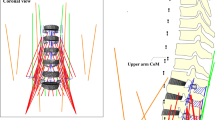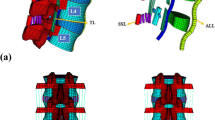Abstract.
The aim of the current study is twofold: first, to compare load sharing in compression between an intact and a surgically repaired lumbar spine motion segment L3/4 using a biomechanically validated finite element approach; second, to analyse the influence of bone mineral density on load sharing. Six cadaveric human lumbar spine segments (three segments L2/3 and three segments L4/5) were taken from fresh human cadavers. The intact segments were tested under axial compression of 600 N, first without preload and then following instrumented stabilisation. These results were compared to a finite element model simulating the effect of identical force on the intact segments and the segments with constructs. The predictions of both the intact and the surgically altered finite element model were always within one standard deviation of the mean stiffness as analysed by the biomechanical study. Thus, the finite element model was used to analyse load sharing under compression in an intact and a surgically repaired human lumbar spine segment model, using a variety of E moduli for cancellous bone of the vertebral bodies. In both the intact and the surgically altered model, 89% of the applied load passed through the vertebral bodies and the disc if an E modulus of 25 MPa was used for cancellous bone density. Using 10 MPa – representing soft, osteoporotic bone – this percentage decreased, but it increased using 100 MPa in both the intact and the altered segment. Thus, it is concluded that reconstruction of both the disc and the posterior elements with the implants used in the study recreates the ability of the spine to act as a load-sharing construction in compression. The similarity in load sharing between normal and instrumented spines appears to depend on assumed bone density, and it may also depend on applied load and loading history.
Similar content being viewed by others
Author information
Authors and Affiliations
Additional information
Electronic Publication
Rights and permissions
About this article
Cite this article
Pitzen, T., Geisler, F., Matthis, D. et al. The influence of cancellous bone density on load sharing in human lumbar spine: a comparison between an intact and a surgically altered motion segment. Eur Spine J 10, 23–29 (2001). https://doi.org/10.1007/s005860000223
Received:
Revised:
Accepted:
Issue Date:
DOI: https://doi.org/10.1007/s005860000223




